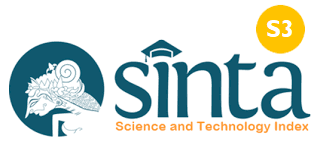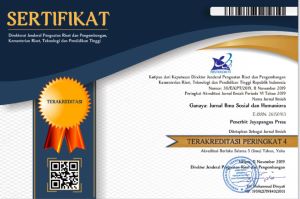The Influence of Flood Disasters on Economic Growth and Poverty in Indonesia
DOI:
https://doi.org/10.37329/ganaya.v8i1.3657Keywords:
Economic Growth, Poverty, Floods, FEM-FGLSAbstract
This research examines and analyzes the influence of flood disasters on economic growth and poverty in Indonesia. The study has compiled flood data from government agencies for the period of 2014-2022, especially from the Indonesian National Statistics Authority and the National Agency for Disaster Management. Using the quantitative method, this study has employed Full Generalized Least Square to analyze the flood data further and studied their impact on economic growth. Natural disasters have disrupted critical economic activities, including investment and tourism, and certainly affect employment opportunities. This study underscored the importance of strategic disaster managements that deal with social and economic issues, namely supervision and control, socio-economic strengthening, hydrological and preparedness information systems, disaster resilience infrastructure, spatial planning, and risk mapping, as well as forest and land rehabilitation. It is expected that such government interventions could enhance the reciprocal synchronization of data and the information needed, which is crucial to equalizing the components of Hazard, Capacity, and Vulnerability, especially between Ministries and institutional partners. Moreover, optimizing the analysis of regional development projections and spatial planning is necessary. It includes the use of more comprehensive data and information regarding existing disaster management programs and their implementation. By this, a comprehensive analysis can be carried out and investment needs can be identified. This also includes consideration of climate change aspects in disaster hazard analysis. There is still a need to synchronize flash flood disaster hazard data into analysis, as well as synchronize and share data between both parties for capacity and vulnerability components.
References
Amarasinghe, U., Amarnath, G., Alahacoon, N., & Ghosh, S. (2020). How Do Floods and Drought Impact Economic Growth and Human Development at the Sub-National Level in India?. Climate, 8(11), 1-17.
Ashizawa, T., Sudo, N., & Yamamoto, H. (2022). How Do Floods Affect the Economy? An Empirical Analysis using Japanese Flood Data. Bank of Japan Working Paper Series.
Bai, J., Choi, S. H., & Liao, Y. (2021). Feasible Generalized Least Squares for Panel Data With Cross-Sectional And Serial Correlations. Empirical Economics, 60(1), 309-326.
Bangalore, M. (2019). Exposure to Floods, Climate Change, And Poverty in Vietnam. Economics of Disasters and Climate Change, 3(2), 80-99.
Bazhal, I. (2019). Innovations as a Crucial Factor of the Catch-up Economic Growth. Scientific Papers NaUKMA. Economics, 4, 3–8.
Ceesay, E. K. (2020). Does Flood Disaster Lessen GDP Growth? Evidence From The Gambia’s Manufacturing And Agricultural Sectors. Journal of Petroleum & Environmental Biotechnology, 11(2), 1–11.
Chen, J., Han, L., & Qu, G. (2020). Citizen Innovation: Exploring the Responsibility Governance and Cooperative Mode of a Post-Schumpeter Paradigm. Journal of Open Innovation: Technology, Market, and Complexity, 6(4), 172.
Chhibber, A., & Laajaj, R. (2008). Disasters, Climate Change and Economic Development in Sub-Saharan Africa: Lessons and Directions. Journal of African Economies, 17(2), ii7–ii49.
Dube, E., Mtapuri, O., & Matunhu, J. (2018). Flooding And Poverty: Two Interrelated Social Problems Impacting Rural Development in Tsholotsho District Of Matabeleland North province in Zimbabwe. Jamba (Potchefstroom, South Africa), 10(1), 1-7.
Ernawati, D. P. (2019). Development of the Tourism Industry as the Motor of Economic Growth in Indonesia. International Journal of Science and Society, 1(4), 145–153.
Felbermayr, G., & Gröschl, J. (2014). Naturally Negative: The Growth Effects of Natural Disasters. Journal of Development Economics, 111, 92-106.
Feng, Z. Y., Wang, C. W., & Lu, Y. H. (2022). The Impact of Climatic Disaster On Corporate Investment Policy. Journal of Multinational Financial Management, 66, 100773.
Grames, J., Prskawetz, A., Grass, D., & Blöschl, G. (2015). Modelling The Interaction Between Flooding Events And Economic Growth. Proceedings of the International Association of Hydrological Sciences, 369(369), 3-6.
Handayani, W., Chigbu, U. E., Rudiarto, I., & Putri, I. H. S. (2020). Urbanization and Increasing Flood Risk in the Northern Coast of Central Java Indonesia: An Assessment towards Better Land Use Policy and Flood Management. Land, 9(10), 343.
Ishiwatari, M., & Surjan, A. (2019). Good Enough Today Is Not Enough Tomorrow: Challenges of Increasing Investments In Disaster Risk Reduction And Climate Change Adaptation. Progress in Disaster Science, 1, 100007.
Junior, M. W., Santos, L., Garcia, R. F., & Trindade, C. (2023). Natural Disasters And Poverty: Evidence From A Flash Flood In Brazil. Environment, Development and Sustainability, 26(9), 1–22.
Kawasaki, A., Kawamura, G., & Zin, W. W. (2020). A local Level Relationship Between Floods and Poverty: A Case In Myanmar. International Journal of Disaster Risk Reduction, 42, 101348.
Khayyam, U. (2020). Floods: Impacts On Livelihood, Economic Status and Poverty In The North-West Region Of Pakistan. Natural Hazards: Journal of the International Society for the Prevention and Mitigation of Natural Hazards, 102(3), 1033-1056.
Krichene, H., Geiger, T., Frieler, K., Willner, S. N., Sauer, I., & Otto, C. (2021). Long-Term Impacts of Tropical Cyclones and Fluvial Floods On Economic Growth Empirical Evidence On Transmission Channels At Different Levels Of Development. World Development, 144, 105475.
Kusumaningsih, F. R., Umar, M. J., Hanum, F., Arum, A., & Fariz, T. R. (2023). Dampak Banjir Pasang Surut (Rob) Terhadap Masyarakat Pesisir Di Kota Semarang. Proceeding Seminar Nasional IPA XIII.
Lawanson, O. I., Proverbs, D., & Ibrahim, R. L. (2023). The Impact of Flooding on Poor Communities In Lagos State, Nigeria: The Case Of The Makoko Urban Settlement. Journal of Flood Risk Management, 16(1), e12838.
Liu, T., & Liu, Z. (2022). A Growth Model with Endogenous Technological Revolutions and Cycles. Journal of Mathematical Economics, 103, 102774.
Mediodia, H. J., Rodriguez, U. P., Garcia, Y., & Paris, T. (2013). Impact of Floods on Economic Growth: Evidence from South and Southeast Asia. Philippine Journal of Social Sciences and Humanities, 18(1), 49-59.
Pan, X., & Qiu, B. (2022). The Impact of Flooding on Firm Performance and Economic Growth. PloS one, 17(7), e0271309.
Parida, Y., Saini, S., & Chowdhury, J. R. (2021). Economic Growth in The Aftermath Of Floods In Indian States. Environment, Development and Sustainability, 23(1), 535–561.
Pecha, G. C. J. (2017). The Effects of Natural Disasters on the Labour Market: Do Hurricanes Increase Informality?. Inter-American Development Bank.
Rahayu, R., Mathias, S. A., Reaney, S., Vesuviano, G., Suwarman, R., & Ramdhan, A. M. (2023). Impact Of Land Cover, Rainfall and Topography On Flood Risk In West Java. Natural Hazards, 116(2), 1735-1758.
Rasool, H., Maqbool, S., & Tarique, M. (2021). The Relationship Between Tourism and Economic Growth Among Brics Countries: A Panel Cointegration Analysis. Future Business Journal, 7(1), 1.
Saputra, D. (2018). Analysis of Factors Affecting Economic Growth in Bangka Belitung Province, Indonesia with LSDV And FGLS Methods. Integrated Journal of Business and Economics, 2, 24.
Schilirò, D. (2017). A Glance at Solow’s Growth Theory. Journal of Mathematical Economics and Finance, 3(5), 83–103.
Shaari, M. S. M., Karim, M. Z. A., & Basri, B. H. (2016). Flood Disaster And Gdp Growth In Malaysia. European Journal of Business and Social Sciences, 4(10), 27–40.
Sun, Q., Mann, J., & Skidmore, M. (2022). The Impacts of Flooding and Business Activity and Employment: A Spatial Perspective on Small Business. Water and Economic Policy, 08(03), 2140003.
Sung, W. T., Devi, I., & Hsiao, S. J. (2022). Early Warning of Impending Flash Flood Based On AIoT. EURASIP: Journal on Wireless Communications and Networking, 2022(1), 15.
Thye, G. L., Kumari, S. S., Lu, Y. S., & Muhairah, S. S. (2021). The Impacts of External and Internal Uncertainties on Income Inequality in The ASEAN 5 Countries. Int. Journal of Economics and Management, 15(3), 351-375.
Utomo, D. D., & Marta, F. Y. D. (2022). Dampak Bencana Alam Terhadap Perekonomian Masyarakat di Kabupaten Tanah Datar. Jurnal Terapan Pemerintahan Minangkabau, 2(1), 92-97.
Willner, S. N., Otto, C., & Levermann, A. (2018). Global Economic Response To River Floods. Nature Climate Change, 8(7), 594–598.
Winsemius, H., Jongman, B., Veldkamp, T. I. E., Hallegatte, S., Bangalore, M., & Ward, P. (2018). Disaster Risk, Climate Change, And Poverty: Assessing The Global Exposure Of Poor People To Floods And Droughts. Environment and Development Economics, 23(3), 328-348.
Downloads
Published
How to Cite
Issue
Section
License
Copyright (c) 2025 Indra Suryadi Ilyas, Catur Susilo Rahardi, Andi Kurniawan (Author)

This work is licensed under a Creative Commons Attribution-ShareAlike 4.0 International License.
An author who publishes in the Ganaya : Jurnal Ilmu Sosial dan Humaniora agrees to the following terms:
- Author retains the copyright and grants the journal the right of first publication of the work simultaneously licensed under the Creative Commons Attribution-ShareAlike 4.0 License that allows others to share the work with an acknowledgement of the work's authorship and initial publication in this journal
- Author is able to enter into separate, additional contractual arrangements for the non-exclusive distribution of the journal's published version of the work (e.g., post it to an institutional repository or publish it in a book) with the acknowledgement of its initial publication in this journal.
- Author is permitted and encouraged to post his/her work online (e.g., in institutional repositories or on their website) prior to and during the submission process, as it can lead to productive exchanges, as well as earlier and greater citation of the published work (See The Effect of Open Access).
Read more about the Creative Commons Attribution-ShareAlike 4.0 Licence here: https://creativecommons.org/licenses/by-sa/4.0/.








